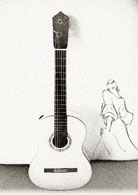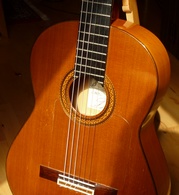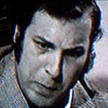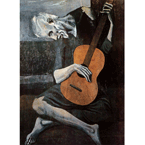Welcome to one of the most active flamenco sites on the Internet. Guests can read most posts but if you want to participate click here to register.
This site is dedicated to the memory of Paco de Lucía, Ron Mitchell, Guy Williams, Linda Elvira, Philip John Lee, Craig Eros, Ben Woods, David Serva and Tom Blackshear who went ahead of us.
We receive 12,200 visitors a month from 200 countries and 1.7 million page impressions a year. To advertise on this site please contact us.
|

|
|
Rationalizing the Bulerias compas
|
You are logged in as Guest
|
|
Users viewing this topic: none
|
|
Login  | |
|

   
alex_lord
Posts: 64
Joined: Dec. 2 2006
From: Vancouver, B.C., Canada

|
 Rationalizing the Bulerias compas Rationalizing the Bulerias compas
|
|
|
[ Warning - LONG ]
Okay, so I've been obsessing with the Bulerias compas for a couple of months and want to see if my current understanding is correct. A lot of this information is digested from the forum's archives (in particular Ricardo's posts, thanks!), other sources, and some good old-fashioned listening. Please don't confuse this information with fact -- it is merely a rationalization that I pieced together, which may or may not be correct. Any feedback would be *greatly* appreciated.
The fundamental 6-count cycle that defines the Bulerias compas is a polyrhythm of 3/4 and 6/8.
Beat: 6 1 2 3 4 5
3/4: 1 & 2 & 3 &
6/8: 1 & a 2 & a
[ I initially had the first beat as "1" but decided to go with "6" to correctly relate this to the common way of counting the 12-count cycle by starting at 12 ]
The basic 12-count cycle, which has accents on 12-3-6-8-10, is just a juxtaposition of two instances of the 6-count cycle, where in one bar the 6/8 meter is emphasized and in the next the 3/4 meter is emphasized. It would be equally correct (a compas) to play continuous 6-beat cycles emphasizing 6-2-4 or 6-3. In other words, you could end up with 12-count cycles like 12-2-4-6-8-10 or 12-3-6-9. This leads me to believe that 12-count cycles are not fundamental but just represent common phrasing.
The other common 12-count cycle has accents on 12-3-7-8-10. The count 7 corresponds to beat "1" of the 6-count cycle. This does not correspond to metric accents of either 3/4 or 6/8, so it appears to be an example of popular syncopation. From a 12-beat perspective, it *should* be equally valid to deemphasize 12 in favor of 1 (i.e., 1-3-6-8-10 or 1-3-7-8-10) and, from a 6-count perspective, the feeling would be exactly the same.
The final common variation I am aware of has accents on 12 and 6. This one seems to me to be the most straight-forward, since 12 and 6 are both "6" in the 6-count cycle. It is the only common accent between the two meters so it makes sense for it to be the downbeat for the entire 6-count cycle.
So, going with the 6-count cycle as a fundamental building block, there are four distinct accent patterns:
1) 6-3
2) 6-2-4
3) 1-2-4
4) 6
Now, on to foot-tapping. The purpose, as I understand it, is to keep a constant beat with your body against which to play the 6-count cycle patterns. Depending on the predominant accent patterns used in the phrasing, some tapping patterns may be more appropriate than others. Here are the 4 variations on the theme (with some real and some made up names).
a) Binary
12-count: 12-2-4-6-8
6-count: 6-2-4
This one seems to be the most universal. It is the 3/4 component of the polyrhythm and 4 of the 5 accents in the standard 12-3-6-8-10 phrase fall on the taps. The only exception is the 3, which (obviously) falls between the taps on 2 and 4. It is very easy to get used to this feeling (tap+accent, tap;accent;tap, tap+accent, tap+accent, tap+accent). It is even easier to break this up into two 6-cycle sub-phrases and feel them separately.
TA T A T
1) 6 1 2 3 4 5
TA TA TA
2) 6 1 2 3 4 5
The other two rhythmic variations of the 6-count cycle can be felt as follows:
T A TA TA
3) 6 1 2 3 4 5
TA T T
4) 6 1 2 3 4 5
b) Ternary
12-count: 12-3-6-9
6-count: 6-3
Triplet feel, particularly fitting for 6/8 compases and falsetas. The metric accent of each beat will correspond to the foot-tap. The four variations can be felt against this beat as follows:
TA TA
1) 6 1 2 3 4 5
TA A T A
2) 6 1 2 3 4 5
T A A T A
3) 6 1 2 3 4 5
TA T
4) 6 1 2 3 4 5
c) Inverse-ternary
12-count: 1-2-4-5-7-8-10-11
6-count: 1-2-4-5
This is the inverse of ternary feel where the foot is tapping along with the upbeats instead of the downbeats. This is also the dobles palmas pattern. The four variations can be felt against this beat as follows:
A T T A T T
1) 6 1 2 3 4 5
A T TA TA T
2) 6 1 2 3 4 5
TA TA TA T
3) 6 1 2 3 4 5
A T T T T
4) 6 1 2 3 4 5
d) Other, 12-count only
12-count: 12-3-6-8-10
12-count: 12-3-7-8-10
These are specialized to follow the accents within certain phrasings. The usefulness, in my understanding, is very limited, for two reasons. First, the regularity of the beat is lost and the foot plays along with the guitar instead of the other way around. Second, the pattern would almost certainly need to change when the accent pattern is changed in the compases or falsetas.
Questions:
1) Did that make any sense at all or am I just making stuff up?
2) Which accents are supposed to be stronger than others? To follow my logic, "6" should always be strongest since it is the downbeat for the entire 6-count cycle. I've also heard that 8 and 10 of 12-count cycle should be louder because they signal the end of one phrase and the beginning of the next. I suppose this is more to do with phrasing than the underlining rhythm.
Cheers,
Alex
|
|
|
|
REPORT THIS POST AS INAPPROPRIATE |
Date Mar. 11 2009 14:34:02
 |
|

   
alex_lord
Posts: 64
Joined: Dec. 2 2006
From: Vancouver, B.C., Canada

|
 RE: Rationalizing the Bulerias compas (in reply to alex_lord) RE: Rationalizing the Bulerias compas (in reply to alex_lord)
|
|
|
Thanks for the responses, guys.
val: The conclusion I was hoping to reach is that Bulerias can always be thought of in 6s. This is why I broke up the two common cycles into 6s (12-3-6-8-10 = 6,3 + 6,2,4 and 12-3-7-8-10 = 6,3 + 1,2,4). From a purely theoretical point of view, my thinking was that you could play these 6-count cycles in any order and still be in compas.
kozz: I've run across Chuck's analysis before but, ironically, it did not make much sense to me at the time. Looking back at it now, some of the terminology I use is different from his, but he does cover a lot of the same ground. I think I may be off on the assertion that that the 6-count cycles may be used in any order, since he says that the 6-2-4 or 1-2-4 are always used for the "resolution phrase." On the other hand, if I understand correctly, there can be many continuous "question phrases" before the resolution. The question phrases can be in the form of 6-3 or 6-2-4/1-2-4).
bursche: The very reason I decided to write this up is because I don't "feel" Bulerias yet. There are a few things that I've learnt that I can play and get into the groove with a compas track, but I tend to get lost when listening to or learning new material. The foot tapping is of particualar interest to me, because I suspect that if I keep practicing keeping a steady beat with my foot and play the various accent patterns against it, I will internalize the compas better.
Munin: My apologies for making your head explode. 
I was really hoping for someone to call me out on this stuff. I think that some of my analysis is correct, but surely not the whole thing...
Any takers? Ricardo? Todd? Jason? Anyone? 
|
|
|
|
REPORT THIS POST AS INAPPROPRIATE |
Date Mar. 13 2009 14:21:49
 |
|

   
Ron.M
Posts: 7051
Joined: Jul. 7 2003
From: Scotland

|
 RE: Rationalizing the Bulerias compas (in reply to alex_lord) RE: Rationalizing the Bulerias compas (in reply to alex_lord)
|
|
|
quote:
My apologies for making your head explode.
Hey Alex,
When analyzing "odd six" passages, it is sometimes helpful to begin counting from 6.
So it becomes
6, 8, 10, 12, 3, 6, 8, 10, 12
Even when counting "normally", I've got used to hearing the accented Bflat starting on 9 now and the 10 being much the same as the 4.
That's because I arranged "Flamenco Master" in two rows of six and not a continuous "clock" or flashing numbers, as others do.
With "Flamenco Master" it's very, very obvious.
And it don't cost nuthin'!  
cheers,
Ron
|
|
|
|
REPORT THIS POST AS INAPPROPRIATE |
Date Mar. 16 2009 12:52:29
 |
|

  
ToddK
Posts: 2961
Joined: Dec. 6 2004

|
 RE: Rationalizing the Bulerias compas (in reply to alex_lord) RE: Rationalizing the Bulerias compas (in reply to alex_lord)
|
|
|
Over analyzing is a killer.
In my opinion, the best way to aquire something like a bulerias compas,
is to do it the way so many others who are great at it, aquired it.
Through dilligent listening and practicing. Not by counting everything,
and overanalyzing.
When my father was teaching me flamenco when i was a little kid, he
never mentioned any numbers.
He played something, and i played it back the best i could. If i got it wrong,
he played it again, till i got it. No counting. Counting is completely counter
intuitive in music. You can count things correctly, and still "Feel" it completely
incorrectly.
You have to concentrate on how something "Feels". The count doesnt matter.
Rhythm, timing, tempo, these are all about "feel", not numbers.
Honestly, i think its a huge crutch, and just makes things worse.
Im positive people will disagree with me on this, but thats just how i feel. 
Just my 2,
TK
_____________________________
|
|
|
|
REPORT THIS POST AS INAPPROPRIATE |
Date Mar. 16 2009 14:17:59
 |
|

   
Ricardo
Posts: 14825
Joined: Dec. 14 2004
From: Washington DC

|
 RE: Rationalizing the Bulerias compas (in reply to alex_lord) RE: Rationalizing the Bulerias compas (in reply to alex_lord)
|
|
|
You are sort of on the right track, but what Todd is saying is the most important thing. The analyze away if it is fun for you, but nothing matters until you FEEL it and it is natural to groove with it and never get lost.
One important thing you are missing is with the 6's, there is a fundamental accent pattern you did not have up there. Sort of related to your 7,8 10 thing, but more important. The PALMAS accent a certain way, and when you play, you have to groove with that feeling, or play AGAINST the palmas sometimes. The accent of the palmas is 1,3 of a 6 phrase, or 1,3, 7,9 of a 12 phrase. That is super important and missing from your analysis. In addition, you can sometimes have a lesser accent on 5 and 11 with palmas, which gives a total "up beat" accent pattern, against the 3/4 (foot on 6,2,4, or 12,2,4,6,8,10). And you have to make your playing groove against that like when you play against any other "up beat" music.
In the case where you have ternary feel, 12,3,6,9, those palmas still work perfect, you just don't feel the 3 and or the 9 so "up", they feel more "down", which is fine as long as it all grooves. When closing on 10, many players I hear don't feel the 9 so good, which is just as important as the 3 IMO.
Ok the other thing you miss in your analysis is the importance of relating the rhythm of Buleria to Solea. It is a different feel, but shows the importance of the 12 beat phrase vs the 6 beat phrase. In other words, there are times when yes bulerias HAS to be thought of as 12 beats. These things are learned easier when you accompany dance, and they become intuitive like Todd was saying. There are shifting feels that happen in bulerias, and they are easier learned just by doing it and grooving, accompanying dancers and singers, etc, than by mathematical analysis.
Ricardo
_____________________________
CD's and transcriptions available here:
www.ricardomarlow.com
|
|
|
|
REPORT THIS POST AS INAPPROPRIATE |
Date Mar. 16 2009 20:50:06
 |
|

   
gato
Posts: 322
Joined: Jun. 9 2007

|
 RE: Rationalizing the Bulerias compas (in reply to alex_lord) RE: Rationalizing the Bulerias compas (in reply to alex_lord)
|
|
|
I am so glad that people here think that compas should be felt from the heart, and sometimes I get lost counting in digits on the foro, and probably because I expect staves when anylizing music and in this case rhythmic anylisis.  
Have you tried singing the music in your head? That seems to work for me, and at least it keeps me entertained, though I admit it can look very strange! 
Anyway, when ever I play (flamenco) the music (and rhythm) goes round and round in my head, and it makes it fun although that is very pompous to admit! I don't know any other way to say it though, anylisis is a tool that stops me from that, and puts me in to 'anylisis mode.' So the two 'modes' are different, at least to me........but you're on the right path, so keep it up.
Gary
|
|
|
|
REPORT THIS POST AS INAPPROPRIATE |
Date Mar. 17 2009 12:07:43
 |
|

   
alex_lord
Posts: 64
Joined: Dec. 2 2006
From: Vancouver, B.C., Canada

|
 RE: Rationalizing the Bulerias compas (in reply to alex_lord) RE: Rationalizing the Bulerias compas (in reply to alex_lord)
|
|
|
Thanks everyone! It is easy to get caught up in analysis and forget fundamental things like listening and repeating. So, I'll withdraw my original analysis in favor of some really stupid questions.
What would you consider the "right" way to go about listening and assimilating this stuff? I am sure there is more than one way to do it, but I am curious about your opinions. Do you:
1) Listen to a lot of Bulerias
2) Count along (well, Todd clearly doesn't  ) )
3) Do palmas or tap the foot
4) Loop, and perhaps slow down, one or two compases at a time and do 2 and/or 3
I have been doing a lot of 1 with not much benefit, so I am leaning towards 4.
Once you figure out the notes, do you:
1) Play solo and try to replicate the general feel.
2) Play with a metronome / tap feet to ensure that the rhythm is correct and to get up to tempo.
3) Play with a compas track to ensure you fit into the compas and get a bit of groove.
4) Play along with the original track.
I tend to go 1-2-3-4-1 here.
A few miscellaneous suggestions that jumped out at me. For the benefit of those who lack the attention span for reading though the entire thread thus far. 
- Ron suggested the Flamenco Master and why it is not represented as a clock.
- Todd emphasized feel over consciously keeping track of where you are.
- Val suggested concentrating on the 10 as the most recognizable beat.
- Ricardo suggested speeding up the Solea to get the Bulerias feel.
- Ricardo also noted that feeling the 1,3 / 7,9 palmas accents is important.
- Jason suggested accenting random beats while staying in compas.
- Gary suggested singing along with the music.
- Doitsujin suggested listening for the main accents and concentrating on the difficult parts first.
Any other tips?
Thanks again, everyone, this is very helpful.
|
|
|
|
REPORT THIS POST AS INAPPROPRIATE |
Date Mar. 17 2009 16:38:37
 |
|

   
Ricardo
Posts: 14825
Joined: Dec. 14 2004
From: Washington DC

|
 RE: Rationalizing the Bulerias compas (in reply to alex_lord) RE: Rationalizing the Bulerias compas (in reply to alex_lord)
|
|
|
quote:
1) Listen to a lot of Bulerias
2) Count along (well, Todd clearly doesn't )
3) Do palmas or tap the foot
4) Loop, and perhaps slow down, one or two compases at a time and do 2 and/or 3
Number 1 and 3. Don't slow down. Just do 3 while doing 1...and even when not doing 1 always keep working on 3.
quote:
Once you figure out the notes, do you:
1) Play solo and try to replicate the general feel.
2) Play with a metronome / tap feet to ensure that the rhythm is correct and to get up to tempo.
3) Play with a compas track to ensure you fit into the compas and get a bit of groove.
4) Play along with the original track.
When learning and practicing, only number 2. In fact, I would say you should be doing number 2 BEFORE you learn the first note, and all along the way. Each note should be learned one to the next while doing number 2. Problem is lots of folks "learn the notes" then try to apply rhythm later, but guess what? Your brain has already assigned arbitrary rhythmic values, and many of them will be WRONG. So now you have to "unlearn" to get the proper rhythm. Your fingers try to lead you, you rush or drag because you want those notes to fall into the space your brain "heard" then land the first time, and you can't groove and let the notes fall where they belong.
After you have "got it", 1,3,4 can be fun to fix small details. But even when you do have it good, you should alwasy come back to working on 2.
Only tip I can add, is when you want to learn a new falseta or rhythm pattern, you can play along AT TEMPO, but keep the foot going tight and do muted strumming along with what ever you are listening too to get the right feel. Sometimes your ear can trick your internal clock to go the wrong way. If you can feel it correct, and hear it correct, you will probably be able to play it. And I concur that singing the rhythm while keeping time with your foot and or hands will help you master rhythms. No need to slow it down.
The hardest thing is to police yourself about your number 3 above, and the number 2 below it. You really need to be sure your are playing in groove to the metronome and your foot is steady. If you are surrounded by other flamencos it becomes painfully obvious when you are off. So record yourself practicing and be self critical always.
Ricardo
_____________________________
CD's and transcriptions available here:
www.ricardomarlow.com
|
|
|
|
REPORT THIS POST AS INAPPROPRIATE |
Date Mar. 18 2009 6:45:39
 |
|

  
srshea
Posts: 833
Joined: Oct. 29 2006
From: Olympia, WA in the Great Pacific Northwest

|
 RE: Rationalizing the Bulerias compas (in reply to alex_lord) RE: Rationalizing the Bulerias compas (in reply to alex_lord)
|
|
|
Well, what I’ve got to add to the discussion is at a far less sophisticated level than what the others have been offering, but here are a couple of ideas that I think have been helpful to me in my own struggle to figure this stuff out (a struggle that I’m still smack dab in the middle of, so I don’t pretend that any of this is actually the right way to go…).
I’ve been spending a lot of time practicing palmas along with one of the loops on a Solo Compas disc. I think it’s easy to turn bulerias into a series of musical cues, a string of specific melodic bits (Bflat on the 3, that standard ligadoed A on the 12, etc.) that guide you from one end of the compas to the other. At least it was (still is) for me. That definitely turns into a problem when you change or remove those musical cues.
So it makes sense to me to remove the melodic aspect entirely and spend a lot of time practicing palmas or strumming on muted strings along with loops and the metronome, and not worrying about counting or chord changes or anything else other than finding the fundamental groove and just sinking into it for a good, long while.
One problem that I’ve had is the need to always “start” feeling/playing/hearing bulerias compas on the 12. Trying to start a simple bit of palmas on 1, for instance, felt totally alien to me, and it would take a compas to two for me to orient myself properly. So when I practice palmas along with one of those long, 15 minute loops I like to start and stop a lot, trying to come in at different points in the cycle and not always have to rely on “grounding” myself in the 12 for things to feel right, which seems like a crutch.
So, this is some of what I’ve been trying out, myself. Hopefully it’s “right”, or at least not too wrong….
Definitely a lot of good stuff from the usual heavy-hitters here, so thanks everyone!
|
|
|
|
REPORT THIS POST AS INAPPROPRIATE |
Date Mar. 18 2009 9:10:00
 |
|

   
andresito
Posts: 377
Joined: Feb. 20 2007
From: New Holland

|
 RE: Rationalizing the Bulerias compas (in reply to ToddK) RE: Rationalizing the Bulerias compas (in reply to ToddK)
|
|
|
quote:
ORIGINAL: ToddK
There is a point at which an english speaker learning, and speaking
spanish, begins to "think" in spanish.
Another analogy: If you haven't listened to a lot of salsa, the first time you try and dance it you'll probably look like you're trying to walk up a flat staircase while wiping something off your shoe... but after listening a lot and absorbing it over time, you find yourself moving to the groove (which is what latin people usually say the first time you try - "The best thing is to just FEEL THE MUSIC" - yeah, right, real easy when you haven't been listening to salsa since before you could walk... or before last week!).
Of course, there are non-natives who have good technique (and get somewhat carried away with it) but not much soul, because they've learnt it in class... the latin people tend to sit in the groove pocket, while the aficionados try to catch each others' eye to sync the next 10 twirls... watch out for those flying elbows, folks! 
_____________________________
¡este arbol tiene duende, cabron!
|
|
|
|
REPORT THIS POST AS INAPPROPRIATE |
Date Mar. 18 2009 14:46:18
 |
|

   
alex_lord
Posts: 64
Joined: Dec. 2 2006
From: Vancouver, B.C., Canada

|
 RE: Rationalizing the Bulerias compas (in reply to alex_lord) RE: Rationalizing the Bulerias compas (in reply to alex_lord)
|
|
|
Todd: I know exactly what you're saying. I moved around a lot when I was younger (in fact, English is my fourth language), so I have experienced the sudden change of perspective when starting to think in a new language, on several occasions. Unfortunately (for me, at least) this kind of osmosis can only happen if I am completely surrounded by the environment. Since I am far from being surrounded by flamenco, I am trying to compensate...
Ron: Good idea. I have a hard time doing it in my head, but I have been meaning to adopt some of songs I used to play on the electric to a compas loop. I wonder what Enter Sandman will sound like when played as a Buleria 
Ricardo: That's exactly what I was looking for, thanks!
srshea: Listening to familiar harmonic changes has also worked for me, but, like you, I have found it to be a crutch. As soon as I would hit a 12-count compas of just Bb, I would get utterly lost. Focusing on the underlining groove seems to be the key. Jumping into the compas in different places sounds like an excellent exercise, and is similar to Jason's suggestion of accenting different beats.
Deniz: You'll have to tell me what solo guitar albums you've been listening to. I always find it a bit easier to pick up on the compas when listening to cante+guitar+palmas than just guitar.
Andreseito: Your analogy is also not entirely lost on me either. Some years ago I was coerced into salsa lessons. I thoroughly did not feel it, but many have felt my elbows of doom 
|
|
|
|
REPORT THIS POST AS INAPPROPRIATE |
Date Mar. 19 2009 13:53:33
 |
|
 New Messages New Messages |
 No New Messages No New Messages |
 Hot Topic w/ New Messages Hot Topic w/ New Messages |
 Hot Topic w/o New Messages Hot Topic w/o New Messages |
 Locked w/ New Messages Locked w/ New Messages |
 Locked w/o New Messages Locked w/o New Messages |
|
 Post New Thread
Post New Thread
 Reply to Message
Reply to Message
 Post New Poll
Post New Poll
 Submit Vote
Submit Vote
 Delete My Own Post
Delete My Own Post
 Delete My Own Thread
Delete My Own Thread
 Rate Posts
Rate Posts
|
|
|
Forum Software powered by ASP Playground Advanced Edition 2.0.5
Copyright © 2000 - 2003 ASPPlayground.NET |
0.1416016 secs.
|


 Printable Version
Printable Version
















 New Messages
New Messages No New Messages
No New Messages Hot Topic w/ New Messages
Hot Topic w/ New Messages Hot Topic w/o New Messages
Hot Topic w/o New Messages Locked w/ New Messages
Locked w/ New Messages Locked w/o New Messages
Locked w/o New Messages Post New Thread
Post New Thread